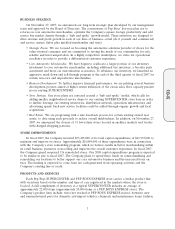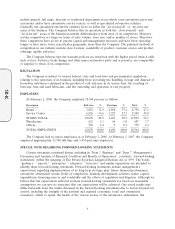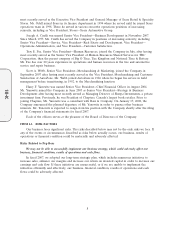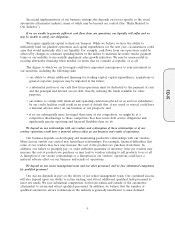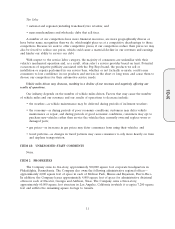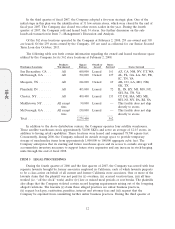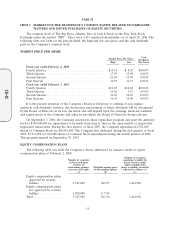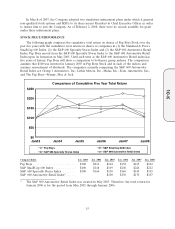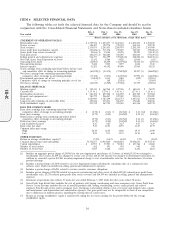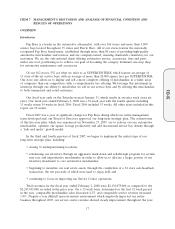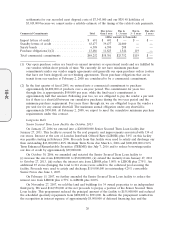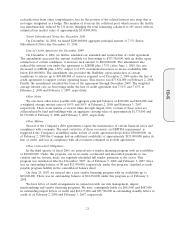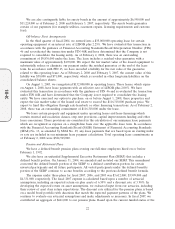Pep Boys 2007 Annual Report Download - page 58
Download and view the complete annual report
Please find page 58 of the 2007 Pep Boys annual report below. You can navigate through the pages in the report by either clicking on the pages listed below, or by using the keyword search tool below to find specific information within the annual report.
In the third quarter of fiscal 2007, the Company adopted a five-year strategic plan. One of the
initial steps in this plan was the identification of 31 low-return stores, which were closed by the end of
fiscal year 2007. The Company also closed two other stores earlier in the year. During the fourth
quarter of 2007, the Company sold and leased back 34 stores. See further discussion on the sale
leaseback transaction in Item 7—Management’s Discussion and Analysis.
Of the 562 store locations operated by the Company at February 2, 2008, 259 are owned and 303
are leased. Of the 259 stores owned by the Company, 105 are used as collateral for our Senior Secured
Term Loan due October, 2013.
The following table sets forth certain information regarding the owned and leased warehouse space
utilized by the Company for its 562 store locations at February 2, 2008:
Products Square Owned or Stores
Warehouse Locations Warehoused Footage Leased Serviced States Serviced
San Bernardino, CA . . All 600,000 Leased 161 AZ, CA, NM, NV, UT, WA
McDonough, GA .... All 392,000 Owned 127 AL, FL, GA, LA, NC, PR,
SC, TN, VA
Mesquite, TX ....... All 244,000 Owned 69 AR, CO, LA, MO, NM,
OK, TX
Plainfield, IN ....... All 403,000 Leased 72 IL, IN, KY, MI, MN, NY,
OH, PA, TN, VA
Chester, NY ........ All 400,400 Leased 133 CT, DE, MA, MD, ME,
NH, NJ, NY, PA, RI, VA
Middletown, NY ..... All except 90,000 Leased — This facility does not ship
tires directly to stores
McDonough, GA .... All except 150,000 Leased — This facility does not ship
tires directly to stores
Total ............. 2,279,400 562
In addition to the above distribution centers, the Company operates four satellite warehouses.
These satellite warehouses stock approximately 32,000 SKUs and serve an average of 12-15 stores, in
addition to having retail capabilities. These locations were leased and comprised 78,700 square feet.
Concurrently, during 2006, the Company reduced its outside storage space to provide temporary
storage of merchandise items from approximately 1,000,000 to 100,000 aggregate cubic feet. The
Company anticipates that its existing and future warehouse space and its access to outside storage will
accommodate inventory necessary to support future store expansion and any increase in stock-keeping
units through the end of fiscal 2008.
ITEM 3 LEGAL PROCEEDINGS
During the fourth quarter of 2006 and the first quarter of 2007, the Company was served with four
separate lawsuits brought by former associates employed in California, each of which lawsuits purports
to be a class action on behalf of all current and former California store associates. One or more of the
lawsuits claim that the plaintiff was not paid for (i) overtime, (ii) accrued vacation time, (iii) all time
worked (i.e. ‘‘off the clock’’ work) and/or (iv) late or missed meal periods or rest breaks. The plaintiffs
also allege that the Company violated certain record keeping requirements arising out of the foregoing
alleged violations. The lawsuits (i) claim these alleged practices are unfair business practices,
(ii) request back pay, restitution, penalties, interest and attorney fees and (iii) request that the
Company be enjoined from committing further unfair business practices. During the third quarter of
12
10-K



